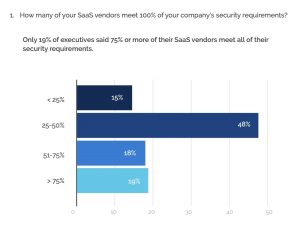With few exceptions, marketing technologies have fallen short of being enterprise-grade technology capable of driving revenue and innovative customer experiences. The rise of software-as-a-service (SaaS) applications helped contribute to this gap, creating a mindset that the enterprise could piecemeal and outsource marketing functionality to a public cloud, chasing one channel at a time. Another reason for a lack of enterprise-grade technology in the martech stack is a general failing to accept marketing as a mission-critical department with the potential to be the top revenue driver for the enterprise.
A recent post by Scott Brinker highlights the inability of most SaaS providers to meet even minimal IT security requirements.

The result is often a fragmented stack, fragmented data, and a fragmented marketing strategy diametrically opposed to an expectation for innovative customer engagements. This fragmentation creates a series of problems for the always-on, always-addressable consumer, in that marketing fails to meet their expectations for timely, relevant, and consistent interactions. Finally, these SaaS-based marketing systems also fail to handle the complexities of other, non-marketing types of messages, which are such an important part of the overall customer experience.
A growing acceptance that marketing is indeed a mission-critical, revenue generator elevates the need for scalability, speed, security, and flexibility in the martech stack. At the core of the flexibility and innovation capacity is a platform requirement that messaging be freed from any channel constraints.
A previous blog in this space explored why marketing is the new standard-bearer for driving a data-driven transformation, responsible for delivering a holistic, personalized customer experience across all channels and interactions with a brand.
Doing so while fulfilling all enterprise requirements with a solution that can sit in a variety of cloud configurations – including your own private cloud where you maintain control over the security perimeter – is a distinguishing feature of a modern marketing platform that creates differentiated, personalized customer experiences that drive revenue.
Messaging and the Overall Brand Experience
Beyond fulfilling enterprise requirements for speed, scale and security, unlocking messaging from channels is a key operational benefit of the Redpoint platform. Whereas marketing campaigns are traditionally organized on a channel basis around list-based processes, this technology is dated as it was tuned to large-scale batch sending of direct mail and email communications. Today’s marketers are best served by a rules-based system, providing for a dynamic (vs. static list-based) customer experiences that are personalized at a segment of one at scale.
A rules-based platform has the power to enable unique customer journeys with the flexibility to dynamically alter every single customer interaction based on a customer’s behavior at the precise moment of a journey. A marketer, then, is always ready with a next-best action for an individual customer at the optimal time, irrespective of a preset expectation, which is impossible to do when marketers are restricted by lists of data or customers tied to a channel. In addition, rules-based systems offer very high levels of re-use which list-based systems cannot touch.
The ability to separate messages from channels across the enterprise not only means the difference between being rules-based vs. list-based, it also means that messaging does not have to be restricted to just marketing-oriented considerations. Because a customer interacts with a brand across touchpoints that extend beyond traditional marketing channels, an enterprise-grade system must remove all barriers that prevent interacting with a customer in real time.
This is the future of what real time means for the enterprise. Separation of messages from channels is a prerequisite for delivering a personalized customer experience that from a customer’s perspective places the consumer in control and effectively meets their expectations.
Development on Five Key Dimensions
A platform that satisfies enterprise technical and security requirements while also manages rules-based messaging across the enterprise clears the final barrier for giving marketers the proverbial head of the table.
There are five requirements that a platform should satisfy that distinguish an enterprise-ready marketing system from a SaaS application that is fine for a departmental or channel-specific function. Satisfying these five dimensions ensures all new customer experiences are squarely aligned with current and future requirements of the enterprise.
- Enterprise-Grade – Enterprise technologies must support common requirements and protocols for critical enterprise applications such as security, scaleability, HA/DR, and single sign-on. The category ensures flexibility across different types of infrastructures, and operates at the cadence of the consumer.
- Cloud Exploitation – Applications must take full advantage of cloud-based technologies such as containerization (Kubernetes, Docker Swarm) to ensure flexibility and scalability in a multi-channel environment with different types of workloads. Being cloud native is a key consideration to meet the sophisticated demands for a seamless, personalized CX across channels and audiences.
- Platform Convergence – One single platform that spans data to analytics to orchestrated interactions, while allowing the last-mile channels to remain in place, is a foundational element of an enterprise-ready system. Convergence essentially entails breaking down the traditional application boundaries with a unified, highly integrated platform to drive consistent and hyper-personalized messages, offers, and engagement.
- Deprecation of Unnecessary Capabilities – Eliminating (or refactoring) unused capabilities greatly simplifies the martech stack. A clean, clear platform is often the first order of business for creating a seamless, holistic experience.
- User Experience – UI development must continue to simplify and expand the transparency and reusability of the application for all levels of users. There is high value in not just re-using a rule, but in knowing what it is you’re using – quickly and easily, to glean a commonality of understanding across all data types.
In summary, flexibility and an innovation capacity defined by scalability, speed, security, and flexibility are fundamental requirements of an enterprise-grade marketing platform freed from traditional channel constraints that delivers hyper-personalized customer experiences in the cadence of a customer journey.
